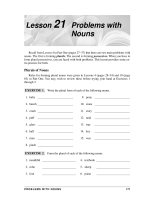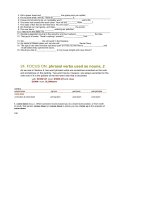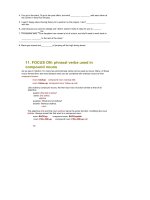UEfAP nouns
Bạn đang xem bản rút gọn của tài liệu. Xem và tải ngay bản đầy đủ của tài liệu tại đây (115.46 KB, 3 trang )
UEfAP Nouns
Grammar in EAPNouns and Nominal GroupsNominal Group
A nominal group or nounbased phrase is typically a group with a noun as its Head. That noun is
likely to be modified either before the noun (premodification) or after the noun (postmodification or
qualification) or both.
Nominal groups typically function as as subject or object in a clause, but can also function as
complements of preposaions in a prepositional phrase or as modifiers.
A typical structure is dmhq – determiner, modifier, head & qualifier. Written academic language uses
nouns and nominal groups to a much greater extent than other word classes (Biber, 2006, p. 48,
137). It would therefore seem sensible for learners of EAP to concentrate on nouns and building
nominal groups rather than verbs and verbal groups. Nominal groups include nominalisation.
Nominal groups (nounbased phrases): Grammar: Nominal Groups
Noun
Nouns are words such as “Smith”, “Oxford”, “letter”, “laughter” & “beauty”. They are defined partly
by their form and partly by their position or function.There are several word endings that indicate
that a word is a noun. Typical examples are “ity”, “ment”, “ness”, “tion”, & “hood”. They usually
change their form (inflect) for plural: “s”, “es”.
With regard to their position, nouns frequently follow determiners “a”, “the”, “this”, “that” and their
main function is Head of a nominal group. Nouns are often classified into common nouns, proper
nouns and pronouns.
Written academic language uses nouns to a much greater extent than other word classes (Biber,
2006, p. 48).
It would therefore seem sensible for EAP learners to concentrate on nouns and building nominal
groups rather than verbs.
Articles
A typical structure of a nominal group is dmhq – determiner, modifier, head & qualifier. An article is
one important type of determiner.
Nominalisation
Nominalisation is the process of forming a noun from some other word class. e.g. red + ness =
redness. EAP uses a large number of nominalisations.
Plural
In English nouns and verbs can be described as singular or plural, depending on the number of
things being referred to. For example “report” is singular, “reports” is plural. Plural nouns are
/>
1/3
common in academic writing (Biber, Johansson, Leech, Conrad & Finegan, 1999, p. 291292).
Modification
A nominal group consists of a head word which may be modified either before the head word
(premodification) or after the head word (postmodification or qualification) or both.
Typical postmodifiers are:
relative clause – students who have no previous experience
toclauses – the solution to the problem of inflation, the question to be debated
ingclauses – a brake consisting of a drum divided into twelve compartments
edclauses – canoes preserved by a hard plaster, a brake consisting of a drum divided into
twelve compartments, the curve shown
prepositional phrase – we need to bring to the box a special tool with a readycompressed spring
adverbial group – the road back, the people outside
adjectival group – varieties common in India, the festival proper, something different
According to Biber, Johansonn, Leech, Conrad & Finegan (1999, p. 606), nominal groups with post
modifiers are common in written texts. The most common postmodifiers in academic texts are
prepositional phrases, followed by relative clauses.
Postmodifiers can be either restrictive or nonrestictive. Overall, restrictive postmodifiers are more
common (85%)in academic texts.
Complement clauses are common postmodifiers: Grammar: Postmodification Complement Clauses
Typical premodifiers are:
adjective – the constitutional aspects
edparticiple – a balanced budget, from the confused events of 1924 August, the emitted light
ingparticiple – growing problem, one striking feature of the years 192931, existing structures
noun – market forces, cabinet appointments
According to Biber, Johansonn, Leech, Conrad & Finegan (1999, p. 589), nominal groups with pre
modifiers are three to four times more common in written texts than in conversation. Adjectives and
nouns are the most common premodifiers in academic texts.
Participles are used for both preand postmodification: Grammar: Participles
Adjectives & Adjectival Groups
Adjectives and adjectival groups are commonly used in academic texts as pre or post modifiers in
nominal groups. (Biber, Johansson, Leech, Conrad & Finegan, 1999, p. 506).
For example:
premodification – the constitutional aspects
postmodification – varieties common in India, the festival proper, something different
/>
2/3
Prepositional Phrases
Prepositions are words such as: "up", "on", "in", or "over". A prepositional phrase is
a preposition followed by a nominal group "in the laboratory".
A prepositional phrase is a typlcal postmodifier.
/>
3/3









